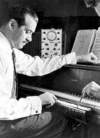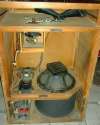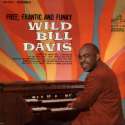Black History Month-The Hammond Organ, the Leslie Speaker and Jazz Organ

That Laurens Hammond(1895-1973)would be written about in an article for Black History Month should probably be considered heresy.
Were it not for his inventing the Hammond organ that has for so long been widely used in Black Gospel churches, there would surely be no connection at all.
I include Hammond's name not only because of his importance in creating an instrument that has had such an impact on gospel and jazz music, but because despite his stubborn racism and pride, the invention he created has pervaded across racial lines, and this is an important aspect to consider during Black History Month.
His first company was called the Hammond Clock Company(1928) and there he developed his famous synchronous motor that revolved in phase with the 60 cycle electric power plant alternating current then becoming standard. This became the foundation of the inner workings that he would develop later for the organ.
He was looking for another invention that would use the technology and parts that made up those used for a clock, and although not a musician, his research, along with associates led to the invention of the first Hammond organ.
The initial importance of the Hammond organ was felt in two important ways-up to that point church organs were large monstrosities that were designed in conjuction with the actual building of a church, the cost to install such an organ was equally enormous, and the organ was a permanent installation.
The Hammond organ was small enough to be carted into an already existing church, and at a hair under 500 lbs, was portable enough to be moved if necessary and inexpensive enough to be purchased by a homeowner or just about any church.

About the same time that the organ was introduced, Don Leslie(shown here with current jazz organ virtuoso Joey DeFrancesco and a Leslie speaker)noted that the problem with the speaker that Hammond sold with his organ was that it didn't reproduce the effect that a pipe organ produces.
In a full pipe organ installation, pipes are located all over a large hall, so that you can experience a sense of sonic direction.
What Leslie did was develop his own speaker, which contained rotating speakers inside a stationary cabinet. This threw the sound all over the performance space.
In the following picture you can see on the top of this opened Leslie the rotating horn that rotates the high frequencies, on the bottom of the speaker rotates a baffle around a lower range speaker.

The resulting effect from being able to switch the speed of the speaker while playing from 'fast' to 'slow' or 'off' was very effective at key points in the music.
Laurens Hammond took great pains to squash Leslie-before Leslie started selling his speaker he approached Hammond to go into business together. They arranged a meeting at the Hammond factory and had Hammond organs connected to Leslie speakers. Performers were invited to make comparisons.
Hammond of course turned it down and tried to discourage him in everyway he could.
It was learned later that Hammond executives told the performers not to let Don Leslie 'know that it's any good'.
Hammond also forbid his dealers to sell Leslie speakers, even manufacturing the organ so it would be electronically incompatible with Leslie's speaker, etc.
His great pains did not succeed.
The Hammond/Leslie combination was a marriage seemingly made in heaven, even today a Hammond organ seems incomplete with out a Leslie speaker.
Would Stevie Winwood have been able to record 'Gimmee Some Lovin' if Hammond had succeeded? What about Benmont Tench, longtime organist with Tom Petty & The Heartbreakers? Or The Beatles 'Let it Be'? George Harrison wouldn't have been able to plug his guitar into the Leslie at the end....
The popularity soared after WW II, and Hammond organs were then everywhere-skating rinks, drive in movie theaters, baseball parks, tv and radio studios for use in soap operas and other dramas. There were even local Hammond organ societies that encouraged owners.
The first organ was presented to Henry Ford in 1935, right after Hammond went into production with his new organ.
In 1955 the Hammond organ released model C3, which responded to desire that churches had for a more 'church-looking organ'.

Hammond B3 Organ

Hammond C3 Organ, 'more churchy design', the design on the side of the organ was also matched on the bench.
On the 'other side of the tracks', the Hammond became popular for the reasons already discussed, especially within Black Gospel churches.
Gospel musicians began to realize that the Hammond was good for other music besides gospel.

Wild Bill Davis, one of the first jazz organists, convinced club owners that if they purchased a Hammond organ and Leslie cabinet that a Hammond player, along with a guitarist and drummer, could produce as much sound as any big band, for a fraction of the cost.
Many others followed his path. They were using the organ in a way that Laurens Hammond never intended.
Thus the jazz organ trio was born. It was a smashing success for Blue Note and many other record labels in the 50s and 60s. It began through a new jazz organist who was influenced by Wild Bill-Jimmy Smith. He will be discussed in an upcoming article for Black History Month.
Record labels saw Smith's and Blue Note's success and began looking for their own jazz organ performer.
This of course sold more organs.
Nevertheless, Hammond refused to acknowledge or even capitalize on any of this, and the Hammond Company didn't begin to endorse any jazz organists until after Laurens Hammond's death.
As Laurens Hammond got older and ceded control of the company to others, the Hammond Company began to collaborate with Leslie in many joint projects.
In a humorous twist of events, Suzuki now owns the Hammond and Leslie name under Hammond-Suzuki, and continues to produce Hammond organs using digital technology and Leslie Speakers identical in design to that which Don Leslie began.
Laurens Hammond was undoubtly an engineering genius. In addition to the Hammmond organ and a superior clock, work he did during WWII contributed to guided missle technology. When he died he had almost 100 patents.
Laurens Hammond's pride and his prejudice show that despite what one man may have the power to intend, the true order of the way that things should be is going to happen anyway.
Credits and for more info-
The Hammond Zone
Pete Fallico's Jazz Organ Website
The Beauty in The B-book about the Hammond Organ and Leslie Speaker by Mark Vail


0 Comments:
Post a Comment
<< Home